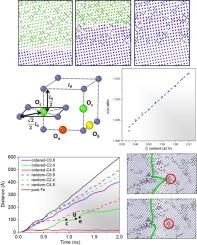当前位置:
X-MOL 学术
›
J. Mater. Sci. Technol.
›
论文详情
Our official English website, www.x-mol.net, welcomes your
feedback! (Note: you will need to create a separate account there.)
Unveiling the mechanism of the carbon ordering and martensite tetragonality in Fe–C alloys studied via deep-potential molecular dynamics simulations
Journal of Materials Science & Technology ( IF 11.2 ) Pub Date : 2024-11-13 , DOI: 10.1016/j.jmst.2024.10.020 Xiao-Ye Zhou, Hong-Hui Wu, Jinyong Zhang, Shulong Ye, Turab Lookman, Xinping Mao
Journal of Materials Science & Technology ( IF 11.2 ) Pub Date : 2024-11-13 , DOI: 10.1016/j.jmst.2024.10.020 Xiao-Ye Zhou, Hong-Hui Wu, Jinyong Zhang, Shulong Ye, Turab Lookman, Xinping Mao

|
The martensitic transformation plays a pivotal role in the strengthening and hardening of steels, yet an accurate interatomic potential for a comprehensive description of the martensitic phase formation in Fe–C alloys is lacking. Herein, we develop a deep learning-based interatomic potential to perform molecular dynamics (MD) simulations to study the martensitic phase transformation across a range of carbon (C) concentrations. The results reveal that an increased C concentration leads to a suppression of phase boundary movement and a deceleration of the phase transformation rate. To overcome the timescale limitations inherent in MD simulations, metadynamics sampling was employed to accelerate the simulations of C diffusion. We find that C atoms tend to cluster at distances equivalent to the lattice parameter of Fe with the same sublattice occupation, leading to local lattice tetragonality. Such C-ordered structures effectively inhibit dislocation movement and enhance strength. The stress field induced by dislocations facilitates a higher degree of ordering. The formation of C-ordered structures is identified as a potentially crucial strengthening mechanism for martensitic steels. The consistency between our simulation results and reported experimental observations underscores the effectiveness of the developed DP model in simulating martensitic phase transformation in Fe–C alloys, providing detailed insights into the mechanisms underlying this process.
中文翻译:

通过深电位分子动力学模拟揭示 Fe-C 合金中碳有序性和马氏体四方性的机制
马氏体相变在钢的强化和硬化中起着关键作用,但缺乏准确原子间电位来全面描述 Fe-C 合金中马氏体相的形成。在此,我们开发了一种基于深度学习的原子间势来执行分子动力学 (MD) 模拟,以研究一系列碳 (C) 浓度下的马氏体相变。结果表明,C 浓度增加导致相边界运动的抑制和相变速率的减速。为了克服 MD 模拟中固有的时间尺度限制,采用了元动力学采样来加速 C 扩散的模拟。我们发现 C 原子倾向于以相当于 Fe 的晶格参数的距离聚集,具有相同的亚晶格占据,导致局部晶格四方性。这种 C 级结构有效地抑制了位错运动并增强了强度。位错引起的应力场有助于更高程度的有序性。C 级结构的形成被认为是马氏体钢的潜在关键强化机制。我们的模拟结果和报告的实验观察结果之间的一致性强调了开发的 DP 模型在模拟 Fe-C 合金马氏体相变方面的有效性,为这一过程背后的机制提供了详细的见解。
更新日期:2024-11-13
中文翻译:

通过深电位分子动力学模拟揭示 Fe-C 合金中碳有序性和马氏体四方性的机制
马氏体相变在钢的强化和硬化中起着关键作用,但缺乏准确原子间电位来全面描述 Fe-C 合金中马氏体相的形成。在此,我们开发了一种基于深度学习的原子间势来执行分子动力学 (MD) 模拟,以研究一系列碳 (C) 浓度下的马氏体相变。结果表明,C 浓度增加导致相边界运动的抑制和相变速率的减速。为了克服 MD 模拟中固有的时间尺度限制,采用了元动力学采样来加速 C 扩散的模拟。我们发现 C 原子倾向于以相当于 Fe 的晶格参数的距离聚集,具有相同的亚晶格占据,导致局部晶格四方性。这种 C 级结构有效地抑制了位错运动并增强了强度。位错引起的应力场有助于更高程度的有序性。C 级结构的形成被认为是马氏体钢的潜在关键强化机制。我们的模拟结果和报告的实验观察结果之间的一致性强调了开发的 DP 模型在模拟 Fe-C 合金马氏体相变方面的有效性,为这一过程背后的机制提供了详细的见解。


















































 京公网安备 11010802027423号
京公网安备 11010802027423号